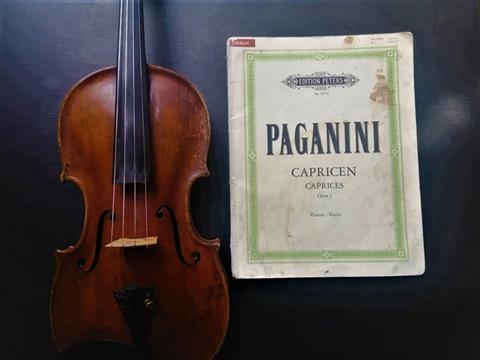Violinist and The Strad’s editorial assistant Rita Fernandes on the importance of reconciling technique and musicality when learning Paganini’s 24 Caprices for Solo Violin

Paganini’s 24 Violin Caprices all but define what we see as ‘violinistic virtuosity’. I’d go as far to say that they are rites of passage for all violinists, which if not attempted, can sadly make some players feel lacking in a certain way. And yet, every violinist either triumphing or getting angry over the pieces has a uniquely different relationship with them.
In my experience, their technical importance was a large focus of my first two years of conservatoire. And when I left the teacher in question, who I not so coincidentally do not remember fondly, I didn’t even look at the book, let alone touch it and god forbid play what was inside it for a year. Ultimately, the detox paid off in an unexpected way. It made me realise why the works hold such a special place in the repertoire. And this is because of the rich musicality within them. Paying attention to this is important with any etude, but is especially characteristic of Paganini’s music, and a fundamental element in enjoying your time learning the Caprices.
The Caprices have an annoyingly clever balance of technique and musicality. With other etudes, it’s easy to get away with saying ‘it’s just an etude, I don’t need to be musical,’ while the opposite approach is sometimes applied to pieces demanding musical maturity. Neither approach should be condoned, but they help us understand how impossible Paganini’s Caprices are to place on the scale. A totally different approach needs to be taken. What that is, is for you to decide, which is a whole adventure in itself. And when you finally strike the balance between musicality and technique, where one informs the other, and vice versa, magic can happen.

Do not take this Paganini ‘two-for-one’ deal for granted, however. Paganini by no means makes one easier just because the other is present! He is all too happy to give you pages of tenths in the context of weird and unexpected harmonies and melodies. No.4 is a particularly good example. The rhythmic framework is constantly changing, with drastic dynamic changes and unexpected harmonic shifts, all while you’re playing scales in thirds and tenths. On the bright side, it gives us a great opportunity to reconcile technique and musicality. If we can isolate one overarching idea in the phrase, the nitty-gritty becomes easier to understand and execute.
In bars 35 and 37 (figure 1), all one needs to imagine is the hand opening and closing. Sure, we can think of ‘D/B-flat sixth, F, E-flat/A-natural tritone, G-flat’ and so on, but the notes are not the point here. The general movement is that of a shrinking and expanding hand – the logic of the writing is simple. Practising the actual notes initially is important, of course, but once these are set, you’re ready to go. We can extend this ‘open-close’ idea to the whole passage, too. The scales in 34 and 36 have an expansive and open feeling while 35 and 37 feel closed and tight. Understanding the passage this way makes the musical interpretation simple. For example, 34 and 36 could have longer bow strokes, to emphasise the scales’ vastness, while 35 and 37 could be grittier and at the heel to amplify the odd chromaticism and cramped feeling. The possibilities are endless. This also has a lot to do with trust. You must trust your hand to perform what you have taught it to do, trust that the musical interpretation informs technique, and trust that Paganini knows how to write for violin – because he does!

Ultimately, technique and musicality are inseparable, and even referring to them as two different entities feels unnatural. But this doesn’t make it any less difficult to actually achieve an interdependence between the two. Paganini’s Caprices give us a unique chance to understand what it looks and feels like to do exactly this. And perhaps if we could emphasise the musicality in all etudes a little more, the enjoyment gained would make their technical goals all the more achievable.











































No comments yet